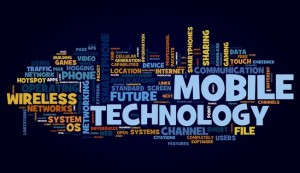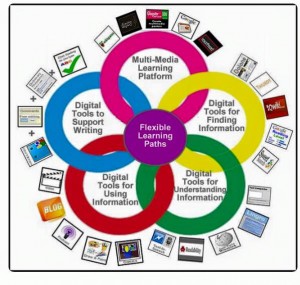Millenials are the pioneers in experiencing the influence of digital tools in the classroom. If 21st century learners manage this trend, they will get the chance to analyze and evaluate how the multimedia world impacts our daily life and most of all, our decisions. Richard Lanham defines digital literacy as “the ability to understand information, however it is presented”. Such information is generally presented as a “mixture” that includes texts, pictures, videos and sounds running at the same time. When the information is so varied and overwhelming, it is not easy to be fluent “in the digital”.
Digital Literacy and Millenials:
David Considine, Julie Horton and Gary Moorman cite How and Straus to define a millennial as “children who have grown up since the emergence of the World Wide Web and the assortment of related digital technologies (e.g., cell phones, text messaging, video games, and instant messaging). Technology is a crucial aspect of their daily lives, and some authors choose to call them “digital natives”. Being online 24/7 does not guarantee that we are able to understand everything that appears on the net. To be a technologically literate citizen we need to understand what technology is, how it works, how it shapes society and in turn how society shapes it (ITEEA). Digital literacy is imperative to gain critical thinking about the digital world we live in. We, as millenials, need to differentiate when multimedia may be really beneficial or truly detrimental to our capacity to think and reflect upon different topics. A good way to start is to understand what the media involves.
Understanding the Media:
David Considine, Julie Horton and Gary Moorman enumerate the “Media principles”, the ones that society should bear in mind when learning from media or digital literacy:
- Media are constructions.
- Media representations construct reality.
- Media have commercial purposes.
- Audiences negotiate meaning.
- Each medium has its own forms, conventions, and language.
- Media contain values and ideology.
- Media messages may have social consequences or effects.
If media are constructions and they build reality, we are part of that process of creating media messages, responses, reactions, perspectives and emotions. If media have commercial purposes, there is also money and power involved in media. If audiences negotiate meaning and each medium has certain style, we can interpret different messages in varied way. Technologically digital citizens analyze, question, reflect upon, and try to understand different perspectives with the digital material found. In doing so, we can recognize ourselves not only as users of the media, but also as people who can be manipulated, used, and tricked through multimedia messages.
Digital literacy and education: teaching a millennial
Before planning or organizing a class, professors are devoting time to understanding the digital world that surrounds students. When professors explore millenials’ world and see what it is interesting and revealing for them, they try to help them build their own view and position towards the media and its power. Although students have diverse backgrounds and opinions on the media, the professor is the one who helps build a bridge between their varied knowledge and digital literacy. Some ways of doing that is discussing topics, unwrapping the media message, and proposing different ways of research and analysis. If students and professors are able to construct the real meaning from what we see on the Internet and on television, the class will reach towards critical thinking and will deepen the dialogue. The education system is the one who has to help teachers and students to build spaces for debate, analysis and creation. The millennial needs to feel that what he is learning is useful for his life outside school and the discussions will be useful today and later on. Considine, Horton and Moorman explain that “Exposing students to multiple texts that evoke emotional responses and tap into popular culture is not dumbing down the curriculum.” These texts foster critical thinking because they are the ones that make us reflect and ask ourselves questions without an explicit or unique answer.
The same authors also point out that “It should be noted that media literacy is not merely teaching with or through media or technology. Using an overhead projector, the Internet, a SMART board, a DVD, or a VCR is not, in and of itself, media literacy.” After understanding the world in which millenials are immersed, professors face the challenge of coping with the means used by millenials. This does not mean only basing a class on a media tool to deliver a presentation or to watch a movie with the class. Those elements should be used to awaken students’ ideas on the issues the movie present, how it is shown, who made the film, when was released, and what is the implicit message behind it. Applying this analysis, focused on the process of an element or a situation, to print texts, songs, blogs, social networks and the Internet as a whole, students would be able to evaluate whatever they want.
Sinclair says that: “we will not ‘unlearn’ how to read and write for print, but we can expand our repertoire beyond it.” Going beyond is fostering students ability to explore, to try harder, to make mistakes, and to be immersed in a new way of expressing their thoughts through digital literacy. Basing this challenging proposal on the skills we have learned for print, we can be part of the digital world. Digital literacy enables us to analyze and work with every text, print and non-print. Digital literacy has a place for everything and everybody, and millenials are the ones who can engage in this with their skills.
Sinclair also points out that “a student might be missing from a potential dialogue because they do not yet understand it sufficiently to engage in it or to ‘try on’ the discourse of the field. They may need to be exposed to the dialogue at a more appropriate level” Although millenials live in an environment in which digital media is presented nearly everywhere, sometimes they have problems being good, active members of it. They seem to be more comfortable behind a screen that in front of other people. Teaching students how to express themselves in front of people to reach discussion and analysis is also a challenging but rewarding task. Professors who work for that goal, provide students strategies to compare, contrast, critique, and analyze any text or multimedia context they have in front of them.
The T.A.P. model:
Considine, Horton and Moorman present a useful tool to analyze the actors involved on the media: The Media Triangle.
This triangle invites us to start deepening our analysis on the media. The analysis involves the text, its medium, the genre, and the characteristics that make it unique, debatable and meaningful in our world. We can also reflect upon the media by the way certain element is produced. Students can think about the authors, the techniques used, and some regulations that influence its shape and the impact the text wants to have on the audience. In adition to this, the audience can be also analyzed. The target audience also influences the way in which we express ideas. By using this triangle as a guide, professors and students are able to create a space to debate and analyze those issues around the digital world, fostering digital literacy.
“Teachers should assist Millennials’ understanding of how media representations of race, class, gender, and sexual orientation affect our society.” (Considine, Horton and Moorman)
Digital divide
As this essay has exposed, digital literacy is important to our 21st critical thinking. But, there are places in the world where the chances to participate in the digital world are limited. According to M.J. Cox, “opportunities to participate in the digital culture, including access to E-learning between developing and developed countries, or within regions (in some countries), can show large differences. Professors need assistance on this controversial issue that should be analyzed and worked on by the government and other bodies that seek for a better education quality. Every school should be able to offer to their students the immediate access to the multimedia world.
There is a digital divide present between professor and students as well. A way of making this distance shorter is to provide professors with regular meetings or workshops where they improve their skills to teach a millennial. The digital divide has to disappear from every possible difference or uneven reality among professors and students and students themselves. In doing so, our society is helping to build an equity of access.
My thoughts
For Millennials, technology and media are part of every aspect of our life. The digital world has shaped our way of communicating, feeling, and experiencing nearly all our emotions, reactions and perspectives. If we really want to be digital citizens, we have to work hard and to accept other’s perspectives and thoughts. We have to learn to be patient and to keep looking. A good way of doing this is to stop basing researches on the first web page that Google shows. Be conscious about media power. We can profit of all the opportunities the media offers, interacting in a analytical way. We can all learn as a community to process information in a good way, developing our skills as digital citizens. The consequences will be better job opportunities and the possibility of success will be close to our goals. Our achievements depend on how we understand technology and media and how we learn and how we use them. We live in a complex environment that requires a constant effort from everybody to keep going with technological advances and chances that will shape our life. Educators have to be involved with their students’ future and a good way of being committed to this is to constantly challenge themselves with new techniques, different texts, controversial issues, and any other tool that foster critical thinking in the class and outside school.
Works Cited:
Considine, David. “Teaching and Reading the Millennial Generation Through Media Literacy.” March 2009. Web. 20 Oct. 2015
Cox, M.J. “Researching IT in education.” September 2013. Web 20 Oct 2015
Lanham, Richard. “Richard Lanham: Digital Literacy.” Richard Lanham: Digital Literacy. Scientific American, 1995. Web. 20 Oct. 2015.
Sinclair, Christine. “Students’ perspectives on academic writing in the digital age.” January 2015. Web 20 Oct. 2015
“Technologically Literate Citizens.” IteaConnect. 1 Jan 2011. Web. 20 Oct. 2015. http://www.iteaconnect.org/TAA/TAA_Literacy.html








